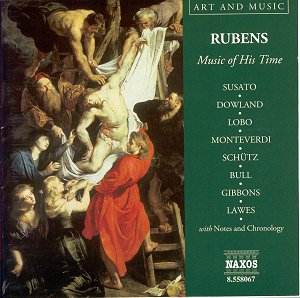This is the fifth in a series of compilations which for the price of a bottle of ‘plonk’ you can buy agreeable ‘musical plonk’ along with some examples of paintings by the selected artist and a good, interesting and educational essay in English (only). A true all-round artistic experience you might think. And I agree. For any student or anyone wanting to discover the Arts this is a good place to start so I am definitely not knocking this enterprising idea.
The other artists featured in this series are Caravaggio, Leonardo, Monet and Picasso. Amazingly the discs do not, as yet, seem to have made their way into the supermarkets, which they hopefully will do by the time you read this.
The Rubens reproductions include the portrait of his son Nicolas and his self portrait of c.1639. Life would not be complete without some of those gloriously plump Rubens naked ladies here disporting in ‘War and Peace’ c.1630. At the back of the 24 page booklet is a chronology with Rubens’ life in one column and other artistic, but mainly musical, happenings in the other. Most informative. However no texts are given, which in the case of the opera extract is something of a nuisance.
The chronology is useful because it highlights the various cities throughout Europe where Rubens worked or with which he can be associated. The music selected reflects these artistic centres.
Susato was Dutch and a Dutch song popular in Rubens’ youth is included (track 2). At the age of one his family moved to Cologne but eleven years later were back in Antwerp where Rubens took his first apprenticeship. John Dowland, an international figure anyway, came to live in the Low Countries a few years later. In 1600 Rubens began to work independently and became court painter to Duke Gonzago in Mantua. The intriguing prospect of a meeting between Rubens and Monteverdi looms, and, oh to have been a fly on the wall. Rubens went to Rome about 1602 and then to Spain in 1603. There he may have met Alonzo Lobo and encountered the music of the conservative Spanish school in contrast to the early opera of Monteverdi (or Peri or Caccini). Two early motets by Schutz are featured. Schutz was a pupil of Gabrieli in Venice at this time.
Back in Antwerp in 1608 Rubens might well have known John Bull, appointed to Antwerp Cathedral as organist after a scandal in England in 1613. Orlando Gibbons’ keyboard music was also in circulation at this time.
In 1630 Rubens was knighted by King Charles I and shortly afterwards completed the canvases for the ceiling of the Banqueting House in Whitehall. William Lawes was Charles I’s Court composer, later to die at the battle of Chester. Quite clearly therefore the music and biography interweave.
The performances are mostly very good particularly the intensely musical Rose Consort and Oxford Camerata. However I have to register disappointment with the Monteverdi extracts by the Capella Musicale di S. Petronia under Sergio Vartole. Although the instrumental playing is agreeable the singers are far too heavy-handed in the Lament and simply dull and not characteristically acceptable in the over twenty minutes of the Orfeo extract. I felt much relieved when it was over.
So, to sum up: an excellent idea, nicely put together and a good introduction to the period.
Gary Higginson




